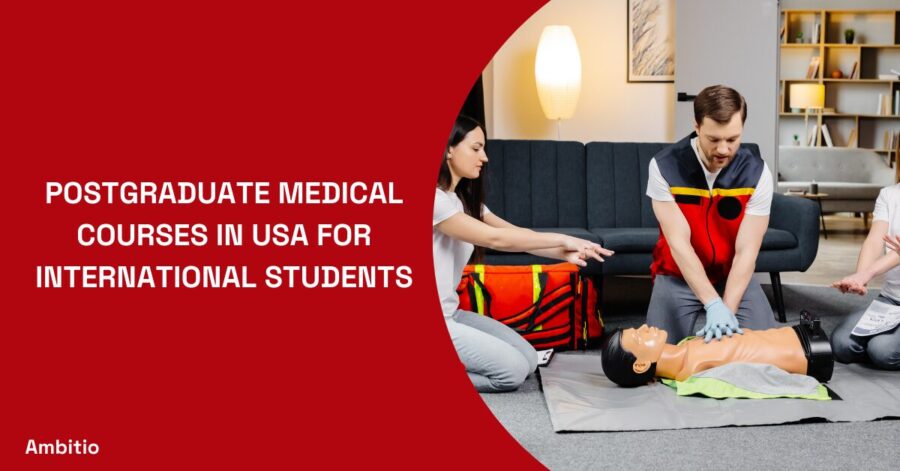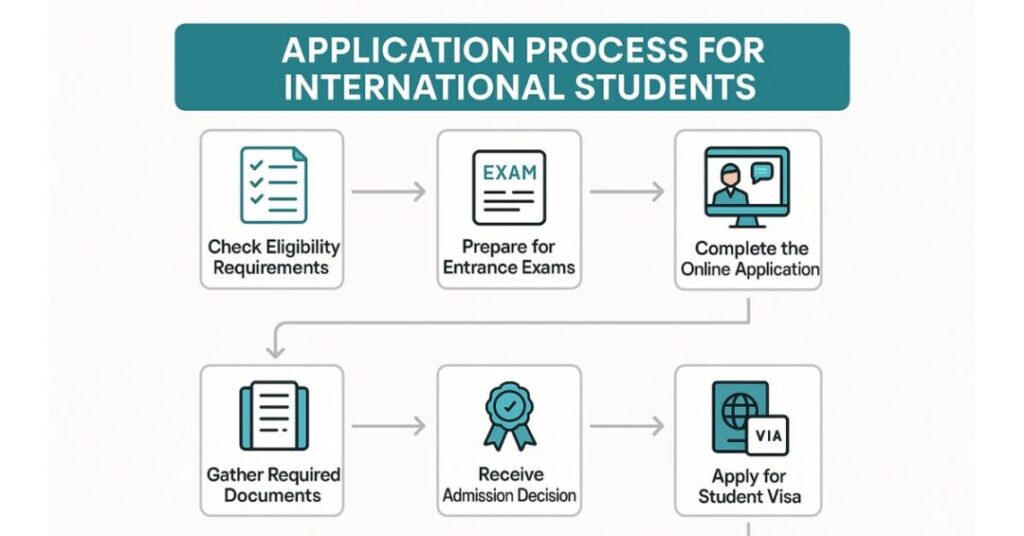9 September 2025
6 minutes read
Postgraduate Medical Courses in USA for International Students

Key Takeaways
- Postgraduate medical courses in USA for international students are offered by 433 universities but demand high tuition, strict eligibility, and exams like USMLE/MCAT.
- Top universities such as Harvard, Stanford, and Johns Hopkins provide world-class training, with total yearly costs averaging $79,500–$109,000.
- Early preparation with exams, visas, and expert guidance like Ambitio’s profile building support can make the journey smoother and more achievable.
Did you know that over 433 universities in the United States offer pathways for international students to pursue advanced medical education? Yet, many face hurdles like sky-high tuition fees in USD, strict eligibility criteria, IELTS or TOEFL requirements, and the challenge of clearing exams like USMLE or MCAT.
For those determined to specialise in areas like pharmacology, biochemistry, or health informatics, postgraduate medical courses in USA for international students provide a realistic route, supported by scholarships, top universities, and globally recognised qualifications.
Why Choose the USA for Postgraduate Medical Education?
The USA is a global leader in postgraduate medicine, offering advanced healthcare courses, specialisation in diverse medical sciences, and pathways like MD in USA. With over 433 institutions, including Washington University and top medical colleges, students gain access to world-class training, research, and patient care.
For Indian students and others who wish to practice medicine in the USA, pursuing postgraduate medical courses in USA for international students ensures globally recognised qualifications, structured residency, and opportunities across the evolving healthcare system.
Types of Postgraduate Medical Courses in the USA for International Students
For those who wish to study abroad and advance their careers in healthcare studies, the USA remains a top destination. With structured residency training, specialised programs, and flexible graduate certificate options, students can choose from a wide range of postgraduate medical courses in USA for international students.

These courses are designed to equip health professionals and MBBS graduates with the skills to practice medicine in the US, pursue advanced research, and gain globally recognised qualifications.
- Residency Programs (MD in the USA)
Designed for MBBS or equivalent graduates, residency programs are compulsory for those who wish to practice medicine in the USA. These programs span 4–6 years and require exams like USMLE Part 1 and 2. - Fellowships and Subspecialisation
After completing residency, students can pursue fellowships in health science, biochemical, or surgical fields. These allow deeper specialisation and are a best match for students aiming at niche expertise. - Master’s Degrees in Medical Sciences and Healthcare
Universities in the USA offering postgraduate medicine degrees and courses provide degree programs in areas like health administration and public health. These programs may require MCAT exam, English proficiency tests like PTE/IELTS, and come with structured admission process. - PhD Programs in Health Sciences
For those inclined towards research in medical sciences, a PhD offers opportunities to work on patient care, biochemical research, and innovations in the healthcare system. Programs vary depending on subject areas and last several years. - Graduate Certificate Programs
Short-term postgraduate courses in medicine such as health informatics or pharmacology give students practical skills. They are cost-effective, ranging in USD per semester, and are ideal for students who want to study without committing to a full MD course.
Eligibility Criteria for Postgraduate Medical Courses in USA
Securing admission into postgraduate medical courses in USA for international students is highly competitive, as the courses in United States are globally recognised and demand strict qualifications.
Students who wish to pursue an MD or specialise in various healthcare fields must not only demonstrate academic excellence but also meet the latest entry requirements set by universities and medical boards. From exams to language proficiency, every step ensures students are prepared to practice medicine in the USA.
- Recognised Medical Degree
Applicants must hold an MBBS or equivalent qualification from their home country. This degree is highly valued when applying for programs lasting 4–6 years such as residency or study MD. - Licensing Examinations
Students are also required to submit scores from USMLE Part 1, 2, and Part 3, or the Medical College Admission Test (MCAT) for certain programs. These exams filter your results and ensure readiness for patient care. - English Proficiency
International students are also required to prove proficiency through IELTS ( 6.5-7.0 ), PTE, or TOEFL. These scores help students meet the requirements of medical colleges like Louis University. - Student Visa and Documentation
To study postgraduate medicine courses, a valid student’s visa is essential. Students may also be required to submit transcripts, recommendation letters, and proof of financial ability to cover the cost to study. - Board Certification & Training
Students who wish to practice medicine in the USA must complete residency, gain board certification, and pass a licensing examination. Programs may include rotations across a range of health care departments. - Additional Requirements
Depending on the degree program or university, students may also be required to submit a personal statement, CV, and undergo an interview. Using a course matcher tool can help identify the best match programs in 2024.
Best Universities Offering Postgraduate Medical Courses in USA
Choosing the right institution is one of the most important steps for students planning to advance their careers.
Below is a list of top universities offering postgraduate medical courses in USA for international students, known for their academic excellence and global recognition.
| University Name | Location | Notable Strengths in Postgraduate Medical Education | Average Tuition Fees (per year) |
|---|---|---|---|
| Harvard University | Massachusetts | World leader in clinical research and medical training | $65,000 – $68,000 |
| Johns Hopkins University | Maryland | Renowned for innovation in healthcare and public health | $62,000 – $65,000 |
| Stanford University | California | Offers cutting-edge programs in medicine and research | $63,000 – $66,000 |
| Mayo Clinic Alix School | Minnesota | Known for patient-centered care and medical research | $58,000 – $61,000 |
| Washington University School of Medicine | Missouri | Strong focus on medical research and postgraduate training | $65,000 – $67,000 |
| University of California, San Francisco (UCSF) | California | Globally ranked for excellence in medical education | $55,000 – $58,000 |
| Yale School of Medicine | Connecticut | Emphasizes research and interdisciplinary learning | $64,000 – $67,000 |
| University of Pennsylvania (Perelman) | Pennsylvania | Prestigious programs in clinical and biomedical sciences | $66,000 – $69,000 |
Costs of Studying Postgraduate Medical Education in USA for International Students
Pursuing postgraduate medical courses in USA for international students involves not only tuition fees but also living expenses, insurance, and other academic costs. The table below provides an overview of average yearly expenses.
| Expense Category | Average Cost (per year) |
|---|---|
| Tuition Fees | $55,000 – $70,000 |
| Accommodation | $12,000 – $18,000 |
| Food & Daily Expenses | $6,000 – $8,000 |
| Health Insurance | $2,000 – $4,000 |
| Books & Supplies | $1,500 – $3,000 |
| Transportation | $1,000 – $2,500 |
| Miscellaneous | $2,000 – $3,500 |
| Total Estimated Cost | $79,500 – $109,000 |
Scholarships and Financial Aid Options to Study Medicine in the USA
Financing education abroad can be challenging, but many scholarships and aid opportunities are available for postgraduate medical courses in USA for international students. These programs help reduce tuition costs and support deserving candidates.
| Scholarship / Aid Program | Coverage Provided | Eligibility Highlights |
|---|---|---|
| Fulbright Foreign Student Program | Tuition, living expenses, airfare | Open to international students with strong academic record |
| AAUW International Fellowships | $20,000 – $50,000 | Female international students pursuing postgraduate studies |
| Harvard Medical School Scholarships | Partial to full tuition support | Based on need and merit for enrolled students |
| Stanford Medicine Financial Aid | Tuition and living expenses | International students demonstrating financial need |
| Mayo Clinic College Scholarships | Tuition assistance | Merit-based support for selected medical students |
| Yale School of Medicine Aid | Full or partial funding | Awarded based on demonstrated financial need |
| Johns Hopkins University Aid | Tuition and research funding | Available to international postgraduate medical students |
Application Process for International Students
Applying for postgraduate medical courses in USA for international students requires careful planning, as universities follow strict procedures.

From meeting academic requirements to securing a visa, each step ensures students are fully prepared to study and train in the United States.
- Check Eligibility Requirements
Review the specific admission criteria for each university, including medical degree recognition, exam requirements, and English proficiency. - Prepare for Entrance Exams
Most programs require exams like USMLE or MCAT, so plan your study schedule and register early to avoid last-minute issues. - Gather Required Documents
Submit academic transcripts, letters of recommendation, a statement of purpose, and proof of financial resources for your studies. - Complete the Online Application
Apply through the university’s portal, carefully filling in details and uploading all required documents before the deadline. - Attend Interviews (if required)
Some universities may conduct interviews to assess your motivation, knowledge, and suitability for the program. - Receive Admission Decision
Universities will review applications and notify selected candidates with an official admission offer. - Apply for Student Visa
Once admitted, secure your student visa by submitting your admission letter, financial proof, and required identification.
Career Opportunities After Postgraduate Medical Courses in USA
Completing postgraduate medical courses in USA for international students opens doors to diverse career opportunities in clinical practice, research, and healthcare leadership. Graduates can work in hospitals, universities, and research centers, contributing to advancements in medicine and patient care.
Many also secure roles in public health, policy-making, and healthcare administration. With globally recognized qualifications, international students can pursue specialized careers or return to their home countries with enhanced expertise, making them highly competitive in the global healthcare workforce.
Conclusion
Pursuing postgraduate medical courses in USA for international students is more than just an academic choice; it’s an investment in a future filled with global recognition, advanced training, and endless opportunities in healthcare. From navigating tough admission processes to managing finances, the journey can be overwhelming without the right guidance.
That’s where Ambitio steps in. With our expertise in profile building and personalized mentoring, we make your dream of studying medicine in the USA achievable. Ready to turn ambition into action? Let Ambitio be your partner in success because your future deserves nothing less.
FAQs
Are there any English language requirements for postgraduate medical courses in the USA?
Yes, non-native English speakers must demonstrate proficiency through standardized tests like TOEFL or IELTS.
Is US clinical experience required for international medical graduates?
While not always mandatory, US clinical experience can be beneficial and is often recommended for international medical graduates seeking residency in the USA.
How can I find out which postgraduate medical courses in the USA are right for me?
Researching universities, evaluating program structures, and considering career goals are essential steps. Utilizing course matcher tools and consulting with academic advisors can also aid in the decision-making process.
What are postgraduate medical courses in USA for international students?
Postgraduate medical courses in USA for international students include MD, MS, and residency programs at accredited American universities.
Are scholarships or financial aid available for postgraduate medical courses in USA for international students?
Some universities offer scholarships or financial aid for postgraduate medical courses in USA for international students, depending on merit and need.
What’s the typical duration and cost of postgraduate medical courses in USA for international students?
Postgraduate medical courses in USA for international students usually take 4–6 years and can cost $50,000–$70,000 per year.
What specialties are available in postgraduate medical courses in USA for international students?
Postgraduate medical courses in USA for international students offer specialties such as Cardiology, Neurology, Pediatrics, Oncology, and Surgery.

You can study at top universities worldwide!
Get expert tips and tricks to get into top universities with a free expert session.
Book Your Free 30-Minute Session Now! Book a call now




























